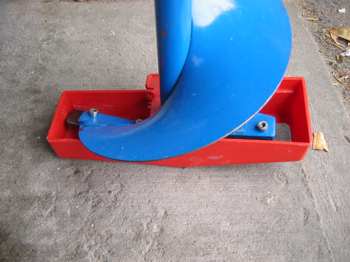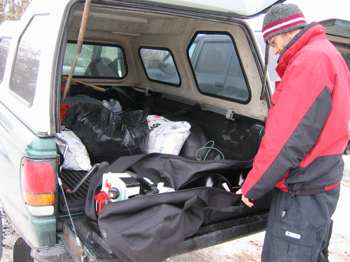|

Tips for Ice Auger Operation and Maintenance
By
Tim Allard
Unless you enjoy chipping holes in the ice with an
axe or a spud, you need an auger to ice fish. When out in the
bitter-cold of winter, I find frustrations intensify and nothing is
worse than having problems with your auger after getting to your
favourite spot. After all, if you can't get through the ice, you
can't fish. Whether you use a hand or a power one, here are some
operation and maintenance tips on keeping your auger in top shape.
Blade Basics:
If your blades aren't razor sharp and in excellent condition, it's
going to take more time and energy to drill through the ice. Both
Mike Seifert of Jiffy Ice Drills and Cy Zieglmeier of StikeMaster
Ice Augers, stress the importance of taking care of an auger's
blades. They are also adamant about never dropping your auger blades
on the ice which ruins their edge and can damage the unit's head.
Zieglmeier notes that one of the biggest mistakes anglers make is
not replacing the blades guards after use. "Augers have a protective
guard to sit over their heads, and without it the blades get
nicked-up (affecting drilling performance). Not only that, it's a
safety hazard as well," he says. Seifert advises anglers to use the
blade protector that is furnished with your drill for a custom fit
and guaranteed protection.

Keeping the blade guard on the auger at all times when not in
use is paramount to preventing blades from getting damaged.
Drilling:
Before drilling holes, anglers should inspect and tighten blade
screws to reduce the chances of loosing parts or causing personal
injury. Any other connections (like the drill and the power head
join) should also be checked for tightness as they can work loose
over time. Zieglmeier explains, "Loose blades change the pitch of
the unit and it won't cut the way it's designed to. If the collar
bolt comes loose where it attaches to the motor you tend to get a
shake in the drill." When drilling the hole, let the blades do the
cutting, but don't exert too much pressure on the auger. Once you've
finished drilling the holes, anglers should shake ice away from the
blades (drying time with a rag if possible) and place the guard on
the auger head. Augers should not be stored upright in a hole
halfway through the ice. Drills can freeze in place and the force
required to remove them can cause significant damage to the unit.
Transport:
Hard-water anglers are drilling more holes and covering greater
distances than ever before. Whether you're traveling by foot or
snowmobile, ensure your auger is properly secured. Granted, carrying
a hand auger can be an over-the-shoulder option, they can also be
fastened to sleds with elastic shock-cords. Yet heavier power augers
need better protection. "Transport your drill with the gas cap up
and the vent screw closed and remember to open the vent again when
you're ready to drill holes," notes Seifert. He also warns, "Damage
can occur to one's ego when you travel quite a ways onto the ice by
snowmobile and then realize you dropped your drill someplace between
the shore and your shanty. Remember to properly secure your ice
drill, or your friends will never let you forget if you don't."
Products are available to lock augers in place on snowmobiles or
ATVs. Additionally, there are a variety of hard-plastic cases or
heavy-duty bags that protect augers for transport in automobiles,
and have handles to make carrying units easier. Some bags also
include pouches to hold items (such as extra spark plugs or spare
blades).
Power Augers Specifics:
Although ice augers are designed to be low-maintenance items,
they do have a few extra requirements than a hand auger. Seifert
advises that users should keep their gasoline fresh and ensure they
have the proper mix of fuel to oil. "The 24:1 gas to oil ratio is
standard because most ice augers today use Tecumseh engines. Use
only a good quality 2-cycle oil. Regular motor oil is not an option.
For convenience sake, I recommend buying the JIFFY Smokeless 2-cycle
oil with fuel stabilizer in the pre-measured containers," he
advises. All owners should check and follow their manufacturer's
instructions regarding the oil and gas ratio. It's also important to
ensure you keep the unit's parts clean, like the air intake, air
filter and spark plugs. Also, when cold starting your auger it's a
good habit to let the engine run and warm up for a few minutes (like
a boat motor) before aggressively drilling holes.
General Storage:
For short-term storage between outings, auger blades should be
dried and lubricated with motor oil or water-displacing lubricant,
like WD-40, to keep the blades from rusting. After treating the
blades, it's best to hang augers vertically, especially power
augers, as laying them horizontally can cause warping of the drill
portion of the unit. Various products are available, including
stands and wall-mounts, to properly store augers. Zieglmeier notes
that for both hand and power augers drills should occasionally be
removed from the rest of the unit to prevent the two pieces from
permanently joining together. Leave them connected too long and the
two parts will seize together, making removing them without causing
damage next to impossible. Upon reassembling the parts, applying a
small amount of grease in between them will help them from rusting
together. "Anything that has an anti-rust component to it, like axle
grease, will work," notes Zieglmeier.

An Auger case is critical to protecting your investment during
travel.
Gas Auger Storage Specifics:
Zieglmeier suggests the following process for preparing the
auger's fuel line for long-term storage. "At the end of the season
there's usually some fuel left in the tank. You want to mix about a
cap-full of fuel stabilizer, like SeaFoam, with the remaining gas,
and then start the motor. You will see the stabilizer working
through the motor, because it will start to smoke. Once this
happens, shut off the motor, dump out the old fuel, and leave it sit
dry with the SeaFoam sitting in the carburetors. This prevents any
fuel from varnishing and causing damage to your unit." Lastly, cover
the engine head with a bag during storage to prevent debris from
collecting in the unit. Some specific bags are made for covering
augers, like StrikeMaster's Storage Parka.
The above preventative maintenance and operating
suggestions will keep your auger cutting through ice for years to
come. It's a good habit to review your unit's operating instructions
each year for operating, maintenance and storage information. Take
the time to keep your auger in top-shape and you won't get stuck
shelling out money for replacement parts and repairs instead of
getting the latest hard-water tackle and catching more fish.
Guard:
Auger Bag:
An Auger case is critical to protecting your investment during
travel.
|